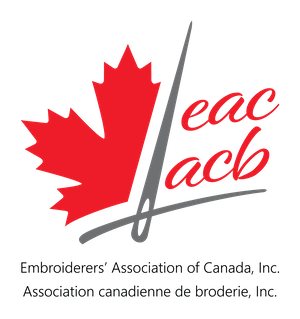Needle-felted Gnomes with Tulip Tree

Tulip Tree Needlearts Guild recently held a one-day workshop on needle felting. A few needles were broken, and a couple of fingers were stabbed, but overall, everyone enjoyed the day and was very pleased with the look of their gnomes. Many thanks to Diane Mugford for leading this workshop. Tulip Tree Needlearts Guild is in the Chatham-Kent area of southwestern Ontario. Reach out by email at chatham-kent@eac-acb.ca to learn more.
CGNA Display at Gananoque Museum
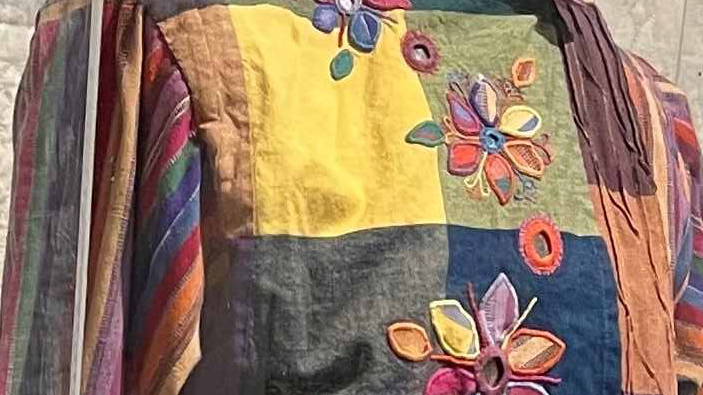
The Cataraqui Guild of Needle Arts (CGNA) of Kingston, Ontario, is participating in Gananoque’s 1000 Islands History Museum‘s “From Away” display until June 2024. Our display includes whitework, blackwork, canvaswork, cross stitch, surface embroidery and Hapsburg lace. Several of our members also belong to the Kingston Heirloom Quilters, who made the tulip quilt (shown from the back) behind the CGNA display you see in the photo. An article about the show is included in the December issue of CGNA’s Gilding the Needle, pages 12 and 13, with more general information in the Gananoque Reporter’s December 24 article, “History Museum brings in fibre arts exhibit From Away.”   If you are in the area, be sure to drop in and see this wonderful exhibit. You’ll be glad you did! Submitted by Cataraqui Guild of Needle Arts, written by Kristeen Kristensen
Instagram Identifier Inspiration
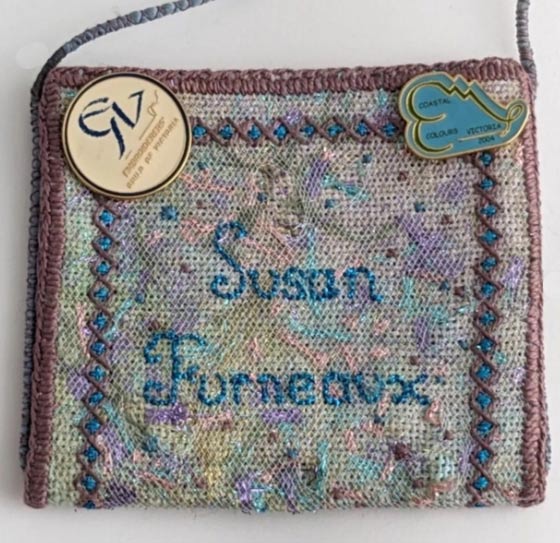
We all need them, we all make them! Let’s see yours! Share your name tag on Instagram. St. John’s Guild of Embroiderers is running an EAC/ACB members’ only contest on Instagram. No worries if you don’t have Instagram — you can just send images in an email to Susan Furneaux at susanfurneaux(insert the @ symbol in place of this statement)gmail.com. At the end of September, a small prize will be awarded to one entry drawn from all submissions received. Good luck! Susan is looking forward to hearing from you. If You Have an Instagram Account If you have Instagram, the Insta is @embroiderystjohns. You can load pictures on and tag @embroiderystjohns to enter. The hashtags for the nametags are #embroiderednametag and #handembroiderednametag. If You Don’t Have an Instagram Account Send an image of your nametag with your pins, bits, and bobs attached. Include who designed it, its technique and how old it is. You can also add any anecdotes you like! Have more than one nametag? Enter twice or three times if you are that organized. Other than your first name and the info above, you will only be mentioned if you want to be tagged. If so, send along your Instagram account.
Memories
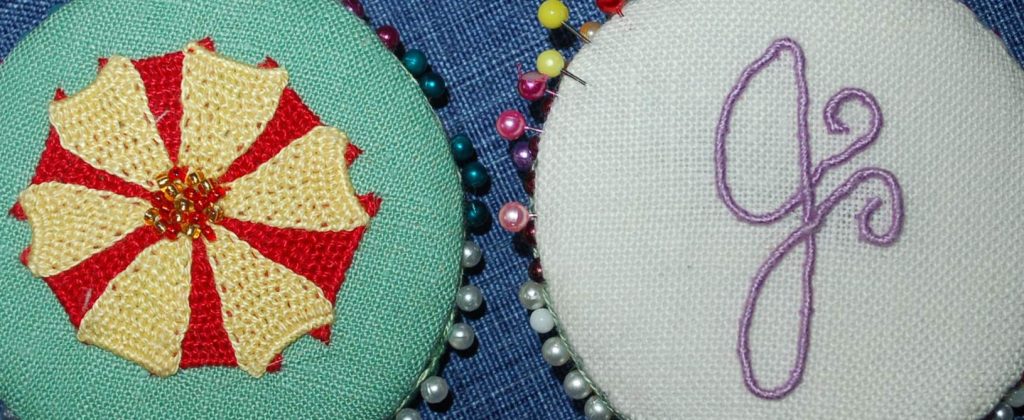
by Odette Gaudet, Chickadee Chapter of Needle Arts “Memory” is defined as the power of remembering; the time during which past things can be remembered; that which is remembered (Highroads Dictionary, 1963). “Remember” is defined as to call to mind; to keep in mind; to use the power of memory; to recollect. Most often, we think memories are only of the past, something that happened long ago. Memories can have a place in the present and future. Chickadee Chapter of Needle Arts had two active members pass away. Susan Pickett at age 65 in November 2013, and Helen Crawford at age 88 in June 2015. As a small guild, this was extremely sad and hard as both women played a strong role in our group. Susan Pickett loved Hardanger. She stitched incredibly beautiful pieces. Her legacy project of stitching a piece for each family member at her passing was incomplete. Guild members finished the remainder. What we learned has been invaluable. Sue liked to change one thing. She would change one colour, for example, white thread on red fabric or blue thread on white fabric. The results were always stunning. She would also change the size or shape. If the piece were square, she’d make it a rectangle. Changing one or two elements can completely alter the look of a project. It’s a great lesson going forward and applies to other projects and life. Helen Crawford loved to stitch. She especially loved cross stitch and mill fabric from Humphrey Textiles, a textile mill in Moncton. The mill plant made fabric of 18-count that was most often used on cubicle wall dividers. When Helen was younger, she could buy a large bag of remnants for five dollars. She stitched everything on this fabric. She made one of everything for each member of her family – pillows, afghans, placemats, wall hangings, bell pulls, coasters, table runners, and ornaments. Anything you can imagine until family members said, “Stitch for yourself, we have enough.” The year before her death, Helen talked about framing the stitched pieces she had finished. I volunteered to help her complete this project. Unfortunately, Helen passed away before we could finish this. Her stash was then passed to her sister, whom I met at the funeral, and we became friends. At the end of 2016, I helped Helen’s sister frame the finished pieces. She then gave one to each of their family members. Even though the family, years before, said, “enough,” being surprised with a final piece by Helen was emotional and meant a great deal as no more will ever be made. Helen’s lesson on stitching is a strong message. You do it because you love it. We put ourselves into what we do, and what we do feeds our souls. Why not fill it with love for those around us and ourselves? In both Susan’s and Helen’s cases, much of their stash was given to our chapter. We sorted through the patterns for future programs. Raw materials were saved for the same purpose. We hosted a tea party in their honour and a stash share, where guild members could come and take any part of the stash home to enjoy. Any remainder was sent to another guild. As part of the Chickadee Chapter of Needle Arts program, we have hosted several projects in their memory. We made Casalguidi pin keeps with Susan’s green fabric. We made flowers on one side and our initials on the other. Susan had white linen that we used to stitch a Schwalm needle case designed by José Hope. We were also able to host an afghan class from Helen’s stash. Our 2021 summer challenge was “hosted” by Helen, making a household item from her fabric supply, using a variety of patterns supplied. Memories are funny. When we miss our friends and family we are often filled with sadness and grief. If we only focus on these thoughts and feelings, we are left in a void of misery. Other times memories give us comfort and joy. Choose what you’ll feel, by choosing where your focus goes. Choose love, fun, and happiness, for yourself. Having stitched pieces with fabric from Susan and Helen is a way to keep them and their memories close. They haven’t really left us. The lessons they taught us and the example they lived are with us. I can hear them when I’m starting a new project. Do I love it? Will I learn something? Can I change one thing that will make it “me”? Most importantly, love what I do and those around me. Life is a full experience waiting for us to embrace. How will you embrace it today?
Alderney Needlearts Guild Stitch in Public
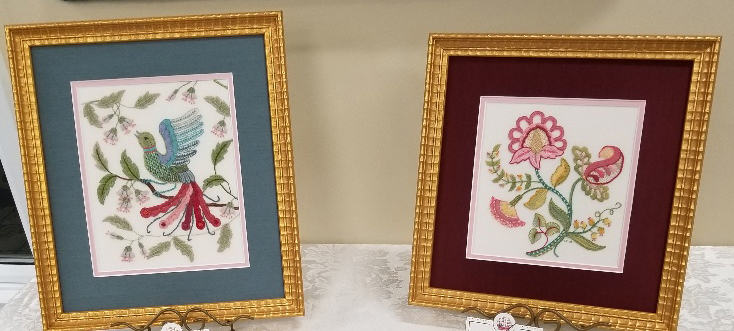
On September 10, 2022, Alderney Needlearts Guild held their first public stitch-in at the Hooked Rug Museum on St. Margaret’s Bay Road. Amongst other items on display was a group project of mandalas which were stitched last year. Little did we know that Hurricane Fiona would hit us the last weekend of September – we were glad that we had our stitch-in earlier in the month! Submitted by Diane Millar on behalf of Alderney Needlearts Guild
More 15-Sided Biscornus
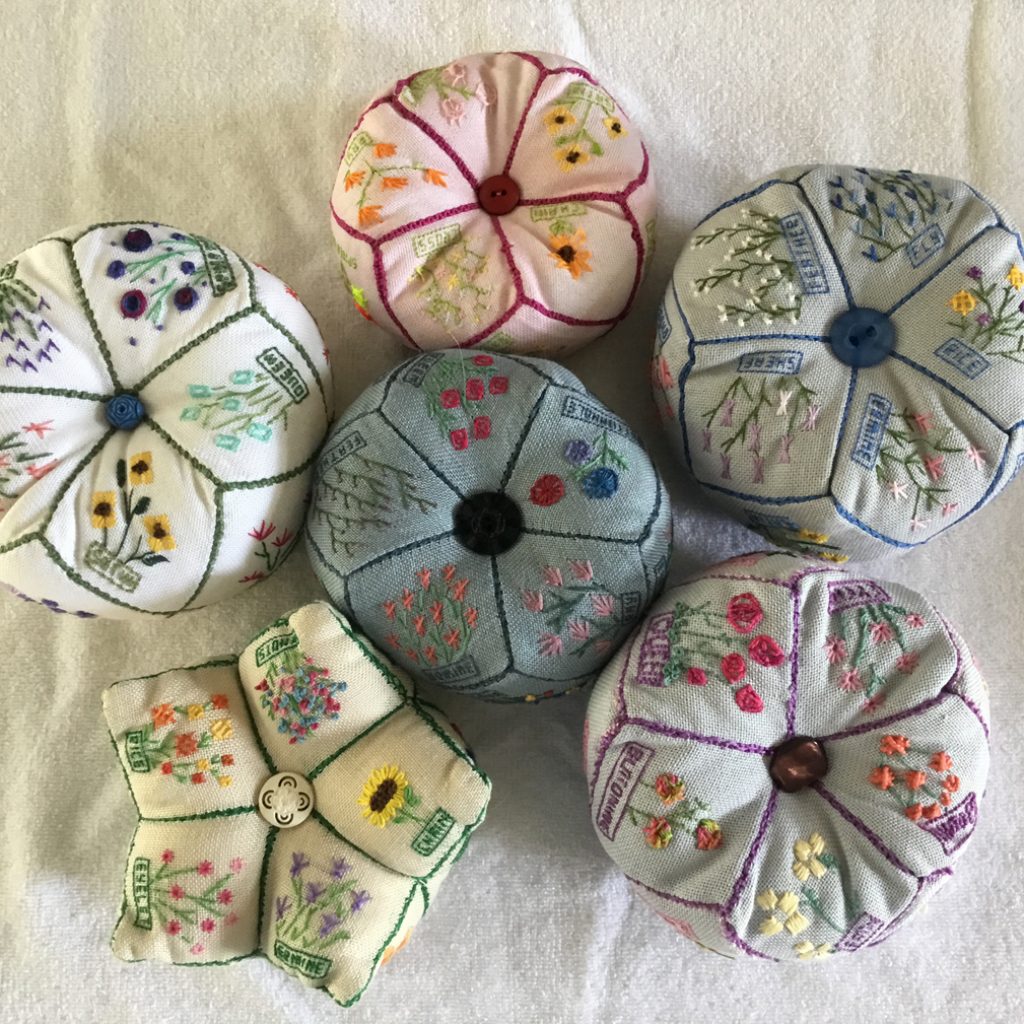
different background fabric and thread colours, and each person’s placement of the flowers make each biscornu unique …
Members Share 15-Sided Biscornu Finishes
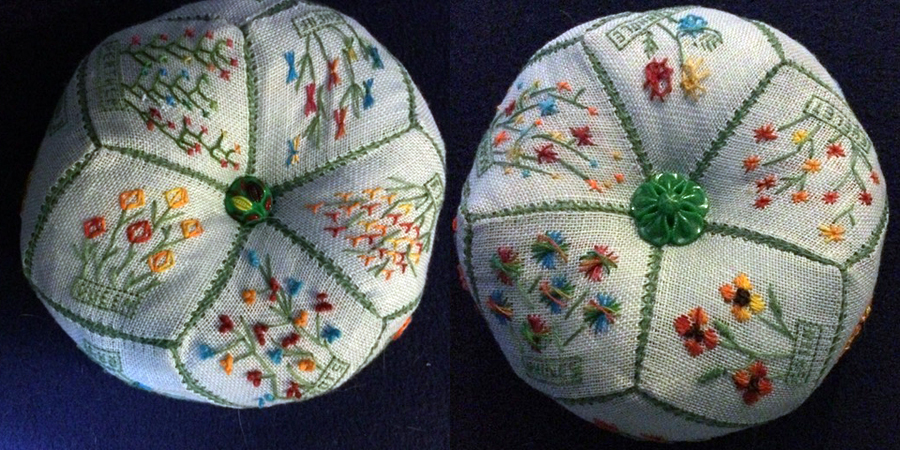
See the beautiful colour choices and a unique finishing option on this project!
Under the Old Oak Tree
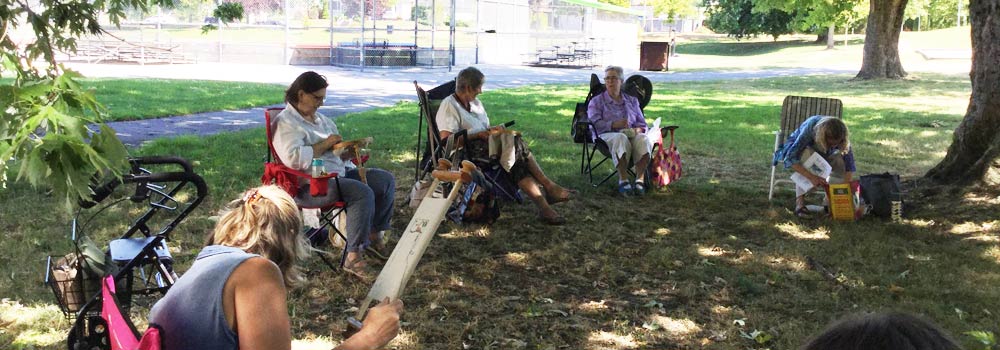
submitted by: Carol Gordon, Membership, Vancouver Guild of Embroiderers We’re calling our summer stitching group Under the Old Oak Tree. Just thought I would show you what our Vancouver Guild does during a very hot day (every second Tuesday) and safe-distancing during the Corona virus. Bring your lunch, a chair and some stitching. What a way to live in glorious Vancouver (not that we’re bragging or anything). So we now have our meetings figured out until the weather changes. We only wish we’d thought to do this during the summer years ago. And what a great way to encourage stitching and encourage friendship! Find out more about what the Vancouver Guild of Embroiderers is up to on their website.
Meeting During Covid-19

Semiahmoo Guild of Needle Arts met regularly on the 1st and 3rd Monday of each month at the White Rock Public Library. When the library closed due to Covid-19, we felt a loss in our lives that was quite profound. Our last get- together was February 17, 2020. We met once after that at one of the members’ homes before the full lockdown came into effect. We kept in touch with occasional emails; however, it wasn’t until two of the members started to meet for coffee, and the restrictions were loosening, that we realized we could actually meet as a group, with proper social distancing. A local park had lots of flat, open space and trees for shade. It seemed like a perfect solution to our dilemma. A sunny day was chosen, a time set, a “what to bring” list sent and then it all fell into place. Eight of us showed up and we had a lovely time! Many brought stitching to work on, and while not a lot of that was done, works in progress were shared for everyone to see. For the most part, our morning was used to catch up with each other. Talk abounded about what we were doing with our time, books read, TV shows watched, cooking and baking accomplishments shared. We watched a group doing a Tai Chi class nearby. There was some talk about politics of course, but mostly we talked about our lives. We have scheduled another park get together, and this time some stitching may actually take place. It is a way of convening that felt safe for everyone involved. It was a wonderful way to stay connected with people who love stitching but don’t always schedule time in their days to do it. This kind of meeting gave us the social connections that we were missing, as well as time to create.
